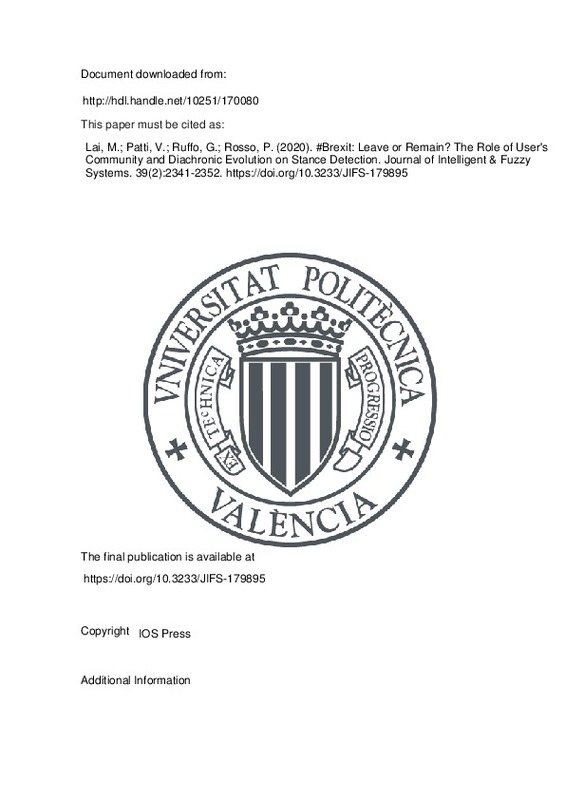Blondel, V. D., Guillaume, J.-L., Lambiotte, R., & Lefebvre, E. (2008). Fast unfolding of communities in large networks. Journal of Statistical Mechanics: Theory and Experiment, 2008(10), P10008. doi:10.1088/1742-5468/2008/10/p10008
Deitrick, W., & Hu, W. (2013). Mutually Enhancing Community Detection and Sentiment Analysis on Twitter Networks. Journal of Data Analysis and Information Processing, 01(03), 19-29. doi:10.4236/jdaip.2013.13004
Duranti A. and Goodwin C. , Rethinking context: Language as an interactive phenomenon, Cambridge University Press, (1992).
[+]
Blondel, V. D., Guillaume, J.-L., Lambiotte, R., & Lefebvre, E. (2008). Fast unfolding of communities in large networks. Journal of Statistical Mechanics: Theory and Experiment, 2008(10), P10008. doi:10.1088/1742-5468/2008/10/p10008
Deitrick, W., & Hu, W. (2013). Mutually Enhancing Community Detection and Sentiment Analysis on Twitter Networks. Journal of Data Analysis and Information Processing, 01(03), 19-29. doi:10.4236/jdaip.2013.13004
Duranti A. and Goodwin C. , Rethinking context: Language as an interactive phenomenon, Cambridge University Press, (1992).
Evans A. , Stance and identity in Twitter hashtags, Language@ Internet 13(1) (2016).
Fortunato, S. (2010). Community detection in graphs. Physics Reports, 486(3-5), 75-174. doi:10.1016/j.physrep.2009.11.002
Gelman, A., & King, G. (1993). Why Are American Presidential Election Campaign Polls So Variable When Votes Are So Predictable? British Journal of Political Science, 23(4), 409-451. doi:10.1017/s0007123400006682
Gonçalves, B., Perra, N., & Vespignani, A. (2011). Modeling Users’ Activity on Twitter Networks: Validation of Dunbar’s Number. PLoS ONE, 6(8), e22656. doi:10.1371/journal.pone.0022656
González, M. C., Hidalgo, C. A., & Barabási, A.-L. (2008). Understanding individual human mobility patterns. Nature, 453(7196), 779-782. doi:10.1038/nature06958
Hernández-Castañeda, Á., Calvo, H., & Gambino, O. J. (2018). Impact of polarity in deception detection. Journal of Intelligent & Fuzzy Systems, 35(1), 549-558. doi:10.3233/jifs-169610
Lazer, D., Pentland, A., Adamic, L., Aral, S., Barabási, A.-L., Brewer, D., … Van Alstyne, M. (2009). Computational Social Science. Science, 323(5915), 721-723. doi:10.1126/science.1167742
Mohammad, S. M., Sobhani, P., & Kiritchenko, S. (2017). Stance and Sentiment in Tweets. ACM Transactions on Internet Technology, 17(3), 1-23. doi:10.1145/3003433
Mohammad, S. M., & Turney, P. D. (2012). CROWDSOURCING A WORD-EMOTION ASSOCIATION LEXICON. Computational Intelligence, 29(3), 436-465. doi:10.1111/j.1467-8640.2012.00460.x
Pang, B., & Lee, L. (2008). Opinion Mining and Sentiment Analysis. Foundations and Trends® in Information Retrieval, 2(1–2), 1-135. doi:10.1561/1500000011
Pennebaker J.W. , Francis M.E. and Booth R.J. , Linguistic Inquiry and Word Count: LIWC 2001, Mahway: Lawrence Erlbaum Associates 71 (2001).
Sulis, E., Irazú Hernández Farías, D., Rosso, P., Patti, V., & Ruffo, G. (2016). Figurative messages and affect in Twitter: Differences between #irony, #sarcasm and #not. Knowledge-Based Systems, 108, 132-143. doi:10.1016/j.knosys.2016.05.035
Theocharis, Y., & Lowe, W. (2015). Does Facebook increase political participation? Evidence from a field experiment. Information, Communication & Society, 19(10), 1465-1486. doi:10.1080/1369118x.2015.1119871
Whissell, C. (2009). Using the Revised Dictionary of Affect in Language to Quantify the Emotional Undertones of Samples of Natural Language. Psychological Reports, 105(2), 509-521. doi:10.2466/pr0.105.2.509-521
[-]







![[Cerrado]](/themes/UPV/images/candado.png)


